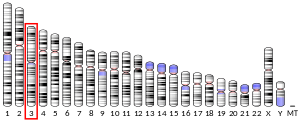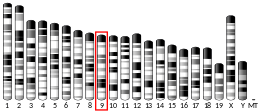SREBP cleavage-activating protein
Sterol regulatory element-binding protein cleavage-activating protein, also known as SREBP cleavage-activating protein or SCAP is a protein that in humans is encoded by the SCAP gene.[5][6][7][8]
SCAP contains a sterol-sensing domain (SSD) and seven WD domains. In cholesterol-depleted cells, this protein binds to sterol regulatory element binding proteins (SREBPs) and mediates their transport from the ER to the Golgi apparatus. The SREBPs are then proteolytically cleaved and stimulate sterol biosynthesis.[5]
Function
SCAP is a regulatory protein that is required for the proteolytic cleavage of the sterol regulatory element-binding protein (SREBP). SCAP is an integral membrane protein located in the endoplasmic reticulum (ER). One of the cytosolic regions of SCAP contains a hexapeptide amino acid sequence, MELADL, that functions to detect cellular cholesterol. When cholesterol is present, SCAP undergoes a conformational change that prevents it from activating SREBP and cholesterol synthesis does not occur.[9]
Structure
Scap has 8 transmembrane domains and both the N-terminal and C-terminal face the cytoplasm. Also, it binds SREBP by a series of consecutive WD repeats on its C-terminus.[10]
References
- 1 2 3 GRCh38: Ensembl release 89: ENSG00000114650 - Ensembl, May 2017
- 1 2 3 GRCm38: Ensembl release 89: ENSMUSG00000032485 - Ensembl, May 2017
- ↑ "Human PubMed Reference:".
- ↑ "Mouse PubMed Reference:".
- 1 2 "Entrez Gene: SREBF chaperone".
- ↑ Nagase T, Seki N, Ishikawa K, Tanaka A, Nomura N (February 1996). "Prediction of the coding sequences of unidentified human genes. V. The coding sequences of 40 new genes (KIAA0161-KIAA0200) deduced by analysis of cDNA clones from human cell line KG-1". DNA Res. 3 (1): 17–24. doi:10.1093/dnares/3.1.17. PMID 8724849.
- ↑ Hua X, Nohturfft A, Goldstein JL, Brown MS (November 1996). "Sterol resistance in CHO cells traced to point mutation in SREBP cleavage-activating protein". Cell. 87 (3): 415–26. doi:10.1016/S0092-8674(00)81362-8. PMID 8898195.
- ↑ Nakajima T, Hamakubo T, Kodama T, Inazawa J, Emi M (1999). "Genomic structure and chromosomal mapping of the human sterol regulatory element binding protein (SREBP) cleavage-activating protein (SCAP) gene". J. Hum. Genet. 44 (6): 402–7. doi:10.1007/s100380050187. PMID 10570913.
- ↑ Sun LP, Seemann J, Goldstein JL, Brown MS (2007). "Sterol-regulated transport of SREBPs from endoplasmic reticulum to Golgi: Insig renders sorting signal in Scap inaccessible to COPII proteins". Proc. Natl. Acad. Sci. U.S.A. 104 (16): 6519–26. doi:10.1073/pnas.0700907104. PMC 1851663. PMID 17428919.
- ↑ Brown MS, Goldstein JL (1999). "A proteolytic pathway that controls the cholesterol content of membranes, cells, and blood". Proc. Natl. Acad. Sci. U.S.A. 96 (20): 11041–8. doi:10.1073/pnas.96.20.11041. PMC 34238. PMID 10500120.
Further reading
- Le Hellard S, Theisen FM, Haberhausen M, et al. (2009). "Association between the insulin-induced gene 2 (INSIG2) and weight gain in a German sample of antipsychotic-treated schizophrenic patients: perturbation of SREBP-controlled lipogenesis in drug-related metabolic adverse effects?". Mol. Psychiatry. 14 (3): 308–17. doi:10.1038/sj.mp.4002133. PMID 18195716.
- McGeachie M, Ramoni RL, Mychaleckyj JC, et al. (2009). "Integrative predictive model of coronary artery calcification in atherosclerosis". Circulation. 120 (24): 2448–54. doi:10.1161/CIRCULATIONAHA.109.865501. PMC 2810344. PMID 19948975.
- Friedlander Y, Schwartz SM, Durst R, et al. (2008). "SREBP-2 and SCAP isoforms and risk of early onset myocardial infarction". Atherosclerosis. 196 (2): 896–904. doi:10.1016/j.atherosclerosis.2007.02.006. PMID 17383658.
- Otsuki T, Ota T, Nishikawa T, et al. (2005). "Signal sequence and keyword trap in silico for selection of full-length human cDNAs encoding secretion or membrane proteins from oligo-capped cDNA libraries". DNA Res. 12 (2): 117–26. doi:10.1093/dnares/12.2.117. PMID 16303743.
- Javitt NB (2002). "Cholesterol, hydroxycholesterols, and bile acids". Biochem. Biophys. Res. Commun. 292 (5): 1147–53. doi:10.1006/bbrc.2001.2013. PMID 11969205.
- Kimura K, Wakamatsu A, Suzuki Y, et al. (2006). "Diversification of transcriptional modulation: large-scale identification and characterization of putative alternative promoters of human genes". Genome Res. 16 (1): 55–65. doi:10.1101/gr.4039406. PMC 1356129. PMID 16344560.
- Lee JN, Gong Y, Zhang X, Ye J (2006). "Proteasomal degradation of ubiquitinated Insig proteins is determined by serine residues flanking ubiquitinated lysines". Proc. Natl. Acad. Sci. U.S.A. 103 (13): 4958–63. doi:10.1073/pnas.0600422103. PMC 1405624. PMID 16549805.
- Lu Y, Dollé ME, Imholz S, et al. (2008). "Multiple genetic variants along candidate pathways influence plasma high-density lipoprotein cholesterol concentrations". J. Lipid Res. 49 (12): 2582–9. doi:10.1194/jlr.M800232-JLR200. PMID 18660489.
- Suchanek M, Radzikowska A, Thiele C (2005). "Photo-leucine and photo-methionine allow identification of protein-protein interactions in living cells". Nat. Methods. 2 (4): 261–7. doi:10.1038/nmeth752. PMID 15782218.
- Irisawa M, Inoue J, Ozawa N, et al. (2009). "The sterol-sensing endoplasmic reticulum (ER) membrane protein TRC8 hampers ER to Golgi transport of sterol regulatory element-binding protein-2 (SREBP-2)/SREBP cleavage-activated protein and reduces SREBP-2 cleavage". J. Biol. Chem. 284 (42): 28995–9004. doi:10.1074/jbc.M109.041376. PMC 2781446. PMID 19706601.
- Yang LH, Chen DF (2007). "[Effects of TNF alpha on the expression of SCAP and triglyceride contents in cultured steatotic hepatocytes]". Zhonghua Gan Zang Bing Za Zhi. 15 (10): 767–70. PMID 17963605.
- Voora D, Shah SH, Reed CR, et al. (2008). "Pharmacogenetic predictors of statin-mediated low-density lipoprotein cholesterol reduction and dose response". Circ Cardiovasc Genet. 1 (2): 100–6. doi:10.1161/CIRCGENETICS.108.795013. PMC 2995295. PMID 20031551.
- Fan YM, Karhunen PJ, Levula M, et al. (2008). "Expression of sterol regulatory element-binding transcription factor (SREBF) 2 and SREBF cleavage-activating protein (SCAP) in human atheroma and the association of their allelic variants with sudden cardiac death". Thromb J. 6: 17. doi:10.1186/1477-9560-6-17. PMC 2645360. PMID 19116028.
- Vasseur F, Caeyseele T, Barat-Houari M, et al. (2010). "Concordance of two multiple analytical approaches demonstrate that interaction between BMI and ADIPOQ haplotypes is a determinant of LDL cholesterol in a general French population". J. Hum. Genet. 55 (4): 227–31. doi:10.1038/jhg.2010.10. PMID 20186155.
- Durst R, Jansen A, Erez G, et al. (2006). "The discrete and combined effect of SREBP-2 and SCAP isoforms in the control of plasma lipids among familial hypercholesterolaemia patients". Atherosclerosis. 189 (2): 443–50. doi:10.1016/j.atherosclerosis.2006.01.001. PMID 16466730.
- Liu X, Li Y, Lu X, et al. (2010). "Interactions among genetic variants from SREBP2 activating-related pathway on risk of coronary heart disease in Chinese Han population". Atherosclerosis. 208 (2): 421–6. doi:10.1016/j.atherosclerosis.2009.08.011. PMID 19740467.
- Chen SN, Cilingiroglu M, Todd J, et al. (2009). "Candidate genetic analysis of plasma high-density lipoprotein-cholesterol and severity of coronary atherosclerosis". BMC Med. Genet. 10: 111. doi:10.1186/1471-2350-10-111. PMC 2775733. PMID 19878569.
- Lee JN, Zhang X, Feramisco JD, et al. (2008). "Unsaturated fatty acids inhibit proteasomal degradation of Insig-1 at a postubiquitination step". J. Biol. Chem. 283 (48): 33772–83. doi:10.1074/jbc.M806108200. PMC 2586246. PMID 18835813.
- Nieminen T, Matinheikki J, Nenonen A, et al. (2007). "The relationship of sterol regulatory element-binding protein cleavage-activation protein and apolipoprotein E gene polymorphisms with metabolic changes during weight reduction". Metab. Clin. Exp. 56 (7): 876–80. doi:10.1016/j.metabol.2007.02.003. PMID 17570245.
This article incorporates text from the United States National Library of Medicine, which is in the public domain.



